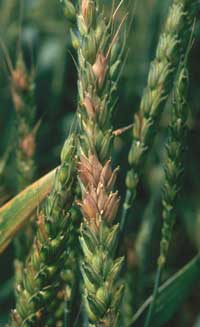South Perth, Western Australia
September 16, 2004
 The Department
of Agriculture,
Western
Australia
will work with growers of summer crops on the State’s south
coast to manage the fungal disease Fusarium head blight. The Department
of Agriculture,
Western
Australia
will work with growers of summer crops on the State’s south
coast to manage the fungal disease Fusarium head blight.
Department
plant industries executive director David Bowran said the
disease was rare in the Western Australian climate, but had been
detected on seven properties from Mt Barker through to
Esperance, all associated with summer cropping.
The initial discovery, made during in-depth
quality assurance testing of a 2003 wheat harvest sample,
prompted follow-up field surveys and paddock inspections by the
Department which had found isolated instances of the disease.
Dr Bowran said many farmers on the South Coast
were considering summer cropping and it was important that grain
growers were pro-active in managing the disease to retain the
State’s reputation as a producer of safe quality food.
He said all South Coast growers would receive an
information package on disease identification, management and
risk factors including summer cropping and stubble retention, to
prevent further development or impact of Fusarium head blight.
“The fungus, Fusarium graminearum, has not
been recorded in Western Australia since 1959 but occurs
sporadically in areas of New South Wales and Queensland,” Dr
Bowran said.
“The Department is advising growers this spring
to review summer cropping plans and rotation practices and to
test seed of maize, millet or sorghum to ensure there is no
inadvertent movement of the disease on seed.”
Fusarium head blight is most prevalent in warm
moist climates where wheat or barley follows a summer crop of
corn, maize or sorghum, which are alternative hosts for the
pathogen.
In wheat and barley it causes affected heads to
ripen prematurely with discoloured and shrivelled grain.
Affected grain is poor quality with reduced seed vigour.
Dr Bowran said the fungus infected a range of
winter and summer cereals and could survive on stubble for a
number of seasons, particularly under no-tillage.
He said spores were produced on the crop residues
during warm moist weather and were dispersed by wind and rain
splash.
“Farmers along the south coast, and particularly
those with a background of summer cropping, are being asked to
lookout for the disease during grain filling this spring,” Dr
Bowran said.
“The first symptoms are individual brown
spikelets and glumes which appear after flowering and can spread
up and down the head. In humid conditions, a salmon pink to
orange fungal growth can appear.”
More information about the disease and how to
look for it will also be made available to growers at upcoming
field days. |